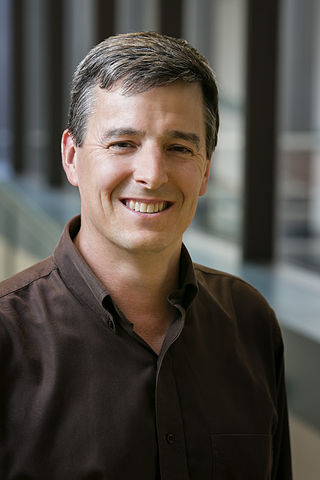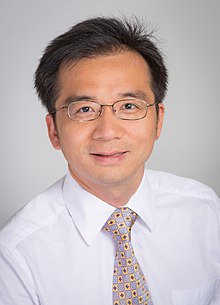
Tweezers are small hand tools used for grasping objects too small to be easily handled with the human fingers. Tweezers are thumb-driven forceps most likely derived from tongs used to grab or hold hot objects since the dawn of recorded history. In a scientific or medical context, they are normally referred to as just "forceps", a name that is used together with other grasping surgical instruments that resemble pliers, pincers and scissors-like clamps.

John A. Rogers is a physical chemist and a materials scientist. He is currently the Louis Simpson and Kimberly Querrey Professor of Materials Science and Engineering, Biomedical Engineering, and Neurological Surgery at Northwestern University.
Raymond David Mindlin was an American mechanical engineer, Professor of Applied Science at Columbia University, and recipient of the 1946 Presidential Medal for Merit and many other awards and honours. He is known as mechanician, who made seminal contributions to many branches of applied mechanics, applied physics, and engineering sciences.
Mehmet Toner is a Turkish biomedical engineer. He is currently the Helen Andrus Benedict Professor of Surgery at Massachusetts General Hospital (MGH) and Harvard Medical School, with a joint appointment as professor at the Harvard-MIT Division of Health Sciences and Technology (HST).

Shu Chien is a Chinese–American physiologist and bioengineer. His work on the fluid dynamics of blood flow has had a major impact on the diagnosis and treatment of cardiovascular diseases such as atherosclerosis. More recently, Chien's research has focused on the mechanical forces, such as pressure and flow, that regulate the behaviors of the cells in blood vessels. Chien is currently President of the Biomedical Engineering Society.
Masayoshi Tomizuka is a professor in Control Theory in Department of Mechanical Engineering, University of California, Berkeley. He holds the Cheryl and John Neerhout, Jr., Distinguished Professorship Chair. Tomizuka received his B.S. and M.S. degrees in mechanical engineering from Keio University, Tokyo, Japan in 1968 and 1970, and his Ph.D. in mechanical engineering from the Massachusetts Institute of Technology in February 1974. He was elected to the National Academy of Engineering in 2022.

Jan Drewes Achenbach was a professor emeritus at Northwestern University. Achenbach was born in the northern region of the Netherlands, in Leeuwarden. He studied aeronautics at Delft University of Technology, which he finished with a M.Sc. degree in 1959. Thereafter, he went to the United States, Stanford University, where he received his Ph.D. degree in 1962. After working for a year as a preceptor at Columbia University, he was then appointed as assistant professor at Northwestern University.

Cristina H. Amon is a mechanical engineer, academic administrator and was the 13th dean of the University of Toronto Faculty of Applied Science and Engineering. She was the Faculty's first female dean. Prior to her appointment at the University of Toronto in 2006, she was the Raymond J. Lane Distinguished Professor and director of the Institute for Complex Engineered Systems at Carnegie Mellon University.
Robert M. Nerem, often referred to as Bob Nerem, a member of the U. S. National Academy of Engineering and the Institute of Medicine, held the Parker H. Petit Distinguished Chair for Engineering in Medicine and Institute Professor Emeritus at the Georgia Institute of Technology where he was an Emeritus Professor until his death.

Nam-Trung Nguyen is a Vietnamese-Australian researcher in the fields of Microfluidics and Nanofluidics. He is notable for his work on nerve agent detector, PCR, Micromixer, Droplet-based Microfluidics, Micro Magnetofluidics, Liquid Marbles and Micro Elastofluidics. He is currently a Professor and Director of Queensland Micro and Nanotechnology Centre at Griffith University. He was a former Associate Professor at Nanyang Technological University, Singapore. Nguyen is a Fellow of ASME and a Senior Member of IEEE.

Xin Zhang is a Distinguished Professor of Engineering at Boston University (BU).
John X. J. Zhang is a tenured professor at Thayer School of Engineering of Dartmouth College, and an investigator in the Dartmouth-Hitchcock Medical Center. Before joining Dartmouth, he was an associate professor with tenure in the Department of Biomedical Engineering at the University of Texas(UT Austin). He received his Ph.D. in electrical engineering from Stanford University, California in 2004, and was a research scientist in systems biology at the Massachusetts Institute of Technology (MIT) before joining the faculty at UT Austin in 2005. Zhang is a Fellow of the American Institute for Medical and Biological Engineering (AIMBE), and a recipient of the 2016 NIH Director's Transformative Research Award.
Craig Alexander Simmons is a Canadian mechanobiologist and professor at the University of Toronto. He received a master's degree in mechanical engineering from Massachusetts Institute of Technology and a Ph.D. in mechanical engineering from the University of Toronto. Simmons contributes to the fields of mechanobiology, stem cells, microfluidics and tissue engineering.
Kathryn Radabaugh Nightingale is an American biomedical engineer and academic in the field of medical ultrasound. She is the Theo Pilkington Distinguished Professor of Biomedical Engineering at Duke University, and an elected fellow of the American Institute for Medical and Biological Engineering (AIMBE) and the National Academy of Inventors (NAI).
Beth L. Pruitt is an American engineer. Upon completing her master's degree in manufacturing systems engineering from Stanford University, Pruitt served as an officer in the United States Navy. She is a full professor of mechanical engineering, biological engineering, and biomolecular science & engineering at the University of California, Santa Barbara. She is a fellow of both ASME and AIMBE.
Jonathan Cooper is Professor of Engineering in the College of Science & Engineering at the University of Glasgow. Professor Cooper has held the Wolfson Chair in Bioengineering at the school since 2009.
Krishnendu Chakrabarty is an Indian-American electrical and computer engineer. He is the Fulton Professor of Microelectronics at Arizona State University Ira A. Fulton Schools of Engineering. Before joining Arizona State, he was the John Cocke Distinguished Professor and was the Chair of the Department of Electrical and Computer Engineering at Duke University Pratt School of Engineering.
Marcia Kilchenman O'Malley is an American mechanical engineer, the Thomas Michael Panos Family Professor in Mechanical Engineering and associate dean for research and innovation for the George R. Brown School of Engineering at Rice University. Her research concerns "systems for enhancing the human sensorimotor control system", including work on exoskeletons, neuroprosthetics, haptic technology, and brain–computer interfaces.
Thomas George Thundat is an Indian-American scientist. He is currently the SUNY Distinguished Professor and a SUNY Empire Innovation Professor of Chemical & Biological Engineering at the University at Buffalo. Thundat conducts research in the field of nanosensors and microcantilevers.

Don L. DeVoe is an engineer recognized for his contributions to the fields of microelectromechanical systems (MEMS) and microfluidics. He is a Professor of Mechanical Engineering at the University of Maryland, College Park, where he serves as Associate Chair of Research and Administration in the Department of Mechanical Engineering. He is a Fischell Institute Fellow within the Robert E. Fischell Institute for Biomedical Devices, and holds affiliate faculty appointments in the Fischell Department of Bioengineering and Department of Chemical and Biomolecular Engineering at the University of Maryland.








